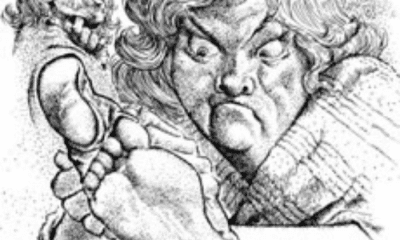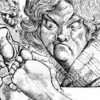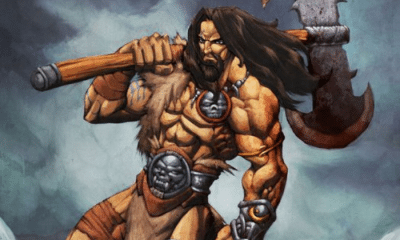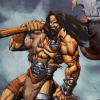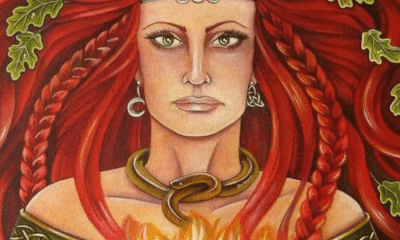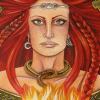
Irish
Who Was the God Cernunnos?
Who Was the God Cernunnos?
He’s one of the most iconic gods of the Celtic pantheon, but almost nothing is known about him. Keep reading to find out how historians interpret Cernunnos, the horned god of Celtic art!
Many cultures left rich written records that tell historians about their gods and worship practices in vivid detail. Other left little evidence for much of their history, but later writers preserved the stories of their cultures to the best of their abilities.
Some groups, however, left no written evidence of their religions. Because they did not write down their legends, historians are left to fill in the blanks.
They do this by looking at evidence from art, artifacts, and what other cultures had to say. They compare unknown figures to more familiar characters to find similarities and possible links.
This is how historians have been able to analyze the Celtic deity known as Cernunnos. Named in just three sources at most, he was nevertheless depicted in dozens of images over the course of hundreds of years.
The horned god, likely an archetype of close-related gods instead of a singular deity, seems to have been an important figure in Celtic religion. While he is pictured often, however, neither Roman sources nor those of later Germanic and Celtic cultures ever elaborated on this widespread image.
Why was Cernunnos largely forgotten and what was his role? Despite the scant evidence, historians believe they can provide at least some insight into Europes mysterious horned god.
The Lost God Cernunnos
Cernunnos is a popular figure in early Celtic religion, but the truth is that very little is known about him.
The name Cernunnos comes from a single Roman-era inscription found beneath Notre Dame Cathedral in Paris. The ruins of a former Roman temple on the site were used to shore up the riverbank and reinforce the foundations of earlier Christian churches on the site.
Construction of a crypt in 1710 uncovered a number of these pieces, including a column commonly called the Pillar of the Boatmen. Commissioned by a shipmakers’ guild in the 1st century AD, the pillar includes the only written reference to a god identified as Cernunnos.
The Pillar of the Boatmen, like many monuments from Roman Gaul, honors both native and Roman gods. Cernunnos appears alongside other Gallic deities like Esus and Smertrios as well as familiar Roman deities such as Jove (Jupiter), Fortuna, and Vulcan.
A similar name found in Luxembourg, “Deo Ceruninco,” is usually thought to refer to the same god. While there is no image on the plaque that mentions this god, it is seen as evidence that the name was known beyond the region of Paris.
Because both the Pillar of the Boatmen and the Luxembourg plaque only include the god’s name, nothing survives of his mythology or any titles or epithets that would further identify him. While Roman writers mentioned other Germanic gods, no one seems to have ever mentioned Cernunnos.
It was common in the ancient world for dominant cultures, like the Romans, to liken foreign gods to their own. They would liken gods who had similar domains or attributes, for example calling local fertility goddesses by the name Ceres or thunder gods Jupiter.
This was not the case with Cernunnos, however. This means that historians cannot use similarities between him and more familiar Greco-Roman gods to determine how he was seen in the ancient world.
Despite this, however, some interpretations can be put forth based on his iconography. While the Pillar of the Boatmen is the only record of the god’s name, his image was much more widespread.
The Horned God
Archaeologists have discovered at least fifty examples of the god they identify as Cernunnos. These are all from the Roman period and have been found in both northern Gaul and in the lands of the Celtiberians, early Celtic people who lived in what is now eastern Spain.
Although these images do not have inscriptions that identify them by name, similarities to the figure depicted on the Pillar of the Boatmen make many historians confident that they are of the same god, or at least of the same archetype.
The Pillar of the Boatmen featured a male deity with stag-like antlers. Each antler had a torc, a gold neck ring that was a symbol of status to the Celts, hanging from it.
Damage to the pillar left the lower part of the god’s body missing, but based on the size and position of his head, it is usually assumed he was seated. This is in keeping with many other images found throughout the region.
Similar gods with horns or antlers appear relatively often in Gallic and Celtiberian art. Often they are sitting in a cross-legged position and most either wear torcs on their horns or hold them in their hands.
Often, similar figures are shown alongside animals. Many images identified as Cernunnos also feature stags, snakes, bulls, or dogs.
A possible earlier example of this is from an elaborate silver cauldron found near Gundestrup, Denmark. Usually dated to the 1st century BC, it shows a seated figure with antlers holding a torc and a snake, surrounded by deer, bulls, and canines.
While most figures of this type come from the Roman era or slightly before, archaeologists believe it may be far more ancient in the region. A similar horned man, for example, is shown in a petroglyph, or rock carving, from the Italian Alps that may have been made as early as the 7th century BC.
The torc included in most horned god images was a symbol of status and wealth in ancient Gallic tribes, but it was not the only such symbol pictured with Cernunnos. Some images also included the god with the type of purse that would have held gold coins.
One such image is not of the mature man usually identified as Cernunnos, but of a child. His antlers, coin purse, and the serpents that flank him, however, lead most historians to identify this as a version of the same god, either from a local variation or from an unknown myth.
Other images identified as Cernunnos do not have the distinctive horns, but there is evidence that they were still important. Some pieces have empty spaces on the head that may have once held either real antlers or ones made of precious materials like gold that have since been lost.
While the name Cernunnos is rarely attested, the similar images found throughout Europe show that this god was likely worshipped by many Celtic tribes in the Roman period. His horns, pose, animals, and symbols of wealth identify him as an important, if forgotten, god of the Celtic world.
The Etymology of Cernunnos
One tool historians can use to interpret ancient figures is linguistics. By understanding the name of a god or heroic figure, they can sometimes pinpoint its origins and possible meaning.
In the case of Cernunnos, his name seems to be a reference to the familiar imagery.
Most historical linguists believe that the name on the Pillar of the Boatmen comes from a common root for “horn.”
Greek sources from the time tell us that the Gauls used karnon as the word for their military trumpets. Like English, most languages of Europe use the same words for this type of horn as for an animal’s.
While the English word “horn” is derived from the same ancient root, we are also familiar with other related words. English words derived from both Greek, such as unicorn, and Latin, like Capricorn or cornucopia, include a similar sound to karnon.
Scholars have also noted that the os sound in the god’s name is typical of Gallic and Celtic gods. More well-attested deities such as the Matronae, Maponos, and Epona all include this element.
The name Cernunnos, therefore, seems to refer to the god’s imagery. His name is usually translated simply as “The Horned One.”
Some, however, question this interpretation.
“…the etymology of whose name is unclear. It seems unlike that (as some have maintained), the name is connected with a Celtic word for “horn”; one would expect, on linguistic grounds, the first vowel to be a rather than e.”
-Bernhard Maier, Dictionary of Celtic Religion and Culture (trans. Edwards)
This belief, however, that the changing vowel sound disproves a linguistic connection is contradicted by both modern examples and ancient evidence.
In our own language, we can see examples of changing vowel sounds with the same root word. “Rhinoceros,” for example, comes from Greek. While their word for “horn” was karnon, the beginning vowel shifted in many words.
Another ancient source provides further evidence that Cernunnos’s name referred to his horns.
An inscription in Greek found in southern France likely refers to the same god as the two Latin sources known from Paris and Luxembourg. It says “Alletinos [dedicated this] to Carnonos of Alisontea.”
“Alisontea” likely refers to a place in Alesia, a region of Gaul. The inscription implies that Carnonos was a local god, or at least a local variation of a god.
This idea of local variation has played a key role in how historians view Cernunnos.
The three known inscriptions that likely refer to the horned god all have slightly different versions of the name. They are also found in regions that belonged to different Celtic tribes.
While the Celts had closely related languages and religions, there were many regional variations. Over time, the various groups across Europe became even more culturally diverse.
It is unlikely, then, that a single identical god was worshiped by all Celtic peoples, even in the same era. While their gods belonged to the same archetype, they were known by local names and had their own myths.
Most historians now believe, therefore, that Cernunnos was likely not the name of a god. Instead, it was a title.
Ancient gods were often known by epithets that were used to refer to them in place of their common name, often in invocations or because of cultural taboos. In Greek, for example, Hades was often called Pluton, “The Wealthy One,” to avoid directly referencing the god of the dead.
A title would have likely remained much more consistent across Celtic tribes than a proper name because their dialects remained very closely related. “The Horned One” would be an epithet that would have only subtle changes to vowel sounds or case endings, whereas a proper name could change much more.
Because the name can be directly translated to refer to a prominent attribute, most scholars believe that Cernunnos was an epithet for the god rather than a proper name. While we may never know what local names the god went by, it is possible that one or more unidentified gods in other sources may be the horned deity by another name.
Possible Roman Links
The Romans commonly equated foreign gods to their own. This did far more than help them to better understand the gods of other people.
To the Romans, this proved the validity of their own religion. All gods were theirs; they were just given different names and seen differently by foreigners.
Creating a syncretic system also reinforced the power of Rome as an imperial state.
The Romans knew that religious persecution could be a rallying issue for potential revolt. By likening the gods of conquered territories to the Roman pantheon, they allowed people to continue worshipping in their own way while still fitting into the state religion.
Roman power was both legitimized and stabilized in this way. Emperors could claim divine authority in the name of local gods of all the cultures they ruled over rather than being seen as wholly foreign by those people.
Most Celtic gods, therefore, were clearly equated with a Roman deity. Inscriptions call them by Roman names with local epithets, Roman writers mention local names for their gods, or images combine their symbols.
It is unusual for a god as wide-spread as Cernunnos appears to have been to have no such syncretization. There are no sources that clearly give a Roman equivalent for the horned god or describe him in Latinized terms.
Some historians have suggested that this is because Cernunnos was so foreign to the Romans that they could see no similarities. This idea is challenged, however, by the fact that the Romans had no such issues with claiming other unique gods in Europe, Egypt, and the Near East.
Instead, many scholars believe that such a link may have been made either in sources that have been lost to us or in a way that has not yet been understood. Particularly because the name Cernunnos was likely an epithet, it is likely that a comparison was made under a different name.
Historians have offered different possibilities for gods Cernunnos may have been compared with based on what is known about him. These include:
- Mercury: Because he sometimes carries a coin purse, some believe he may have occasionally been likened to Mercury, the Roman god of trade.
- Dis Pater: Some of the iconography of Cernunnos, such as snakes and dogs, has links to death and the afterlife in many European cultures. Beliving that the Celtic god may have had similar associations, some think he was compared to a Roman god of the Underworld.
- Janus: Like Mercuty and Dis Pater, this god had implications of crossing boundaries or moving between worlds. This likely comparison is strengthened by the fact that a few known images of Cernunnos similarly show two faces.
- Silvanus: Because of his antlers and association with animals, Cernunnos is often interpreted as a forest god. This makes him a likely counterpart of Silvanus.
- Acteon: Some think the Romans may have seen images of Cernunnos as the Greek character Acteon. After offending Artemis, this skilled hunter was turned into a stag and hunted down by his own dogs.
- Jupiter: Preious contact with other cultures had led to Jupiter being associated with other horned gods, notably the Egyptian deity Amun. This may have led to Cernunnos being seen as a local variation on this same theme.
- Apollo: While not especially common in Roman art, Apollo was sometimes shown as a hnting god with animals in a motif known as The Master of Animals. Resembling images of Cernunnos flanked by stags and hounds, this style was known in the ancient Near East and India as well.
While Cernunnos is not directly named in association with any of these gods, this is not proof that he was never adopted by the Romans. Some of the hundreds of local titles and epithets used by the Romans to syncretize Celtic religion may be unknown references to the horned god.
Cernunnos as a God of Wealth
Many modern sources refer to Cernunnos as the god of the fest. Because he has horns, usually antlers instead of more bull-like horns, and is shown with animals this is a logical interpretation.
Although some of the animals Cernunnos is often shown with were domesticated they still had connections to the wilderness. Dogs were often used in hunting, especially to run down deer, and bulls were sometimes associated with forest gods because they could protect herd against wild predators.
Both could have other connotations, as well. Among these were that both were seen as symbols of wealth.
Bulls, in particular, represented prosperity in many ancient cultures. They were valuable animals and, as seen in Irish legends, rulers often showed their power by owning particularly prized cattle.
The interpretation of Cernunnos as a god associated with wealth is primarly based, however, not on the bulls and dogs he is shown with but on the other attributes he carries.
Most horned god images show him with one or more torcs. These iconic neckbands, often made of gold, were symbols of wealth and leadership in Celtic Europe.
Torcs were often mentioned by the Romans in conjunction with the Celtic tribes. They associated them with warriors; the famous statue of The Dying Gaul shows the fallen warrior wearing nothing but a torc and Pliny the Elder mentioned 183 torcs being taken as spoils of war from a Celtic battlefield.
The Romans also knew that torcs were given as valuable diplomatic gifts. One record mentioned the Gauls giving Caesar Augustus a gold torc weighing one hundred Roman pounds.
This torc would have been far to heavy for even the strongest soldier to wear around his neck, so it’s clear that the torc had another purpose. The size of the gift was proportional to the percieved power and wealth of the wearer.
In addition to prominently displaying this symbol of Celtic wealth, some images of Cernunnos also carry a bag of money. Even if the torc had more symbolic meaning, this is a clear display of material wealth.
One interpretation given by historians is that Cernunnos was a god wealth, but that his prosperity was not always linked to money.
They claim that Cernunnos began as a forest god. He was specifically associated with the bounty that could be found there.
His wealth was that provided by nature. The stags he is shown with were one of the chief sources of meat and leather for early Celts.
As time went on, however, the Celts began to interpret wealth in a different way. Trade throughout Europe increased, and the Celtic tribes began to measure wealth in gold rather than animals or food.
Cernunnos, therefore, may have served both functions. He was a god of the forest’s bounty who came to represent material wealth and prosperity.
This may be why the shipmakers of Paris included Cernunnos on their pillar. Their ships allowed for the trade that brought gold and other valuables to Gaul from around the known world, making the god of wealth one of their most important deities.
A Possible Irish Link
While no myths of Cernunnos survive, some historians believe that he influenced more well-known legends of later cultures.
One of the most likely places for Cernunnos to have been remembered was in Ireland, where Celtic culture lasted long beyond the Roman Age.While other influences created a distinct Gaelic culture, the myths of Ireland and the British Isles often have ties to older Celtic archetypes.
Irish mythology, however, does not include a character that can be immediately identified as a horned god. Instead, some historians have looked to more subtle similarities to find a possible Irish version of Cernunnos.
Both the legendary folk hero Cu Chulainn and his foster brother Conall Cernach have been identified as having possibly been descended from the horned god archetype.
The identification with Cu Chulainn is primarily because of the hero’s close association with dogs. His name, “The Hound of Culann,” came from a story in which he took the place of a guard dog.
This part of the story, some believe, may have originated with a god more closely associated with hunting and, thus, the forest. While Cu Chulainn’s link to Cernunnos is tenuous, he is a popular candidate for and Irish varient of the horned god.
Another likely candidate is Cu Chulainn’s foster brother, Conall Cernach.
The most common reason given for linking the two is linguistic. Conall’s epithet, Cernach, is thought by some to have the same root in the word for “horn” as Cernunnos.
This is usually interpreted as “angular” in the case of Conall Cernach. While this word can be related to that for horn, as shown by the fact that the English word “corner” is taken from the same root, it is not a definitive link.
Conall’s epithet has, in fact, been open to a wide variety of interpretations. Many believe that it is not related at all to the world for horn and instead comes from an Irish word meaning “victorious” or “triumphant.”
In his legends, the only link between Conall and the horned god is similarly vague.
During the Cattle Raid on Fraech, the fort Conall attempted to infiltrate was guarded by a great serpent. Instead of a attacking him, though, the snake wrapped itself around his waist like a belt.
This is the only time that Conall Cernach is associated with any animals, however, and snakes are too common in mythology for Cernunnos to be the only possible god this refers to.
Instead, many historians believe that the Irish figure most influenced by the horned god is actually a Christian saint.
Saint Ciaran of Saighir is said to be the first saint born in Ireland and is one of the island’s Twelve Apostles. In addition to having a similar name, Ciaranus in Latin, the saint is also closely associated with the forest.
According to his hagiography, Ciaran was born into the nobility but renounced his riches after studying Christianity, either in Rome or under Saint Patrick. Instead, he became a hermit living deep in the forest.
While disciples eventually gathered around him and established a proper monastery, Ciaran’s first students were the animals of the forest. Many of the animals he preached to, including stags, wolves, and boars, were those also typically associated with Cernunnos.
If Saint Ciaran’s link to Cernunnos is true, it would be evidence that the horned god was still prominent in at least some areas of the Celtic world at the time of Ireland’s Christianization in the 6th century. Cernunnos would be one of many pagan gods whose legends were adopted and adapted into stories told about holy men in Christian culture.
Cernunnos: The Mysterious God
Cernunnos is the name given to a horned god featured often in art from Roman-era Gaul and Iberia.
The name is taken from a single inscription found beneath Notre Dame Cathedral in Paris. The Pillar of the Boatmen names a horned god as Cernunnos among other, more well-attested, Roman and Gallic deities.
Closely-related names are found in a few other places, but are not mentioned in Roman sources and can only be assumed to refer to the same figure. Based on the name’s etymology, usually translated as “The Horned One,” it is thought that Cernunnos may have been an epithet rather than the god’s proper.
As such, mentions and comparisons made by contemporary Roman writers may have been under a different, unknown name. To interpret Cernunnos without this material, historians have relied largely on the god’s imagery.
Having antlers and oftenbeing surrounded by animals, he is usally seen as a god of the forest. The animals he is linked to may also have been linked to the Underworld and concepts of crossing boundaries.
Representing the wealth of the forest, Cernunnos appears to have eventually represented material wealth as well. He usually wore at least one torc, a neckband that symbolized status in the Celtic world, and sometimes carried a coin purse as well.
While a definitive identification and interpretation of Cernunnos may never be possible, working with existing evidence has allowed historians to give some insight into one of the most mysterious and intriguing figures from the Celtic world.


